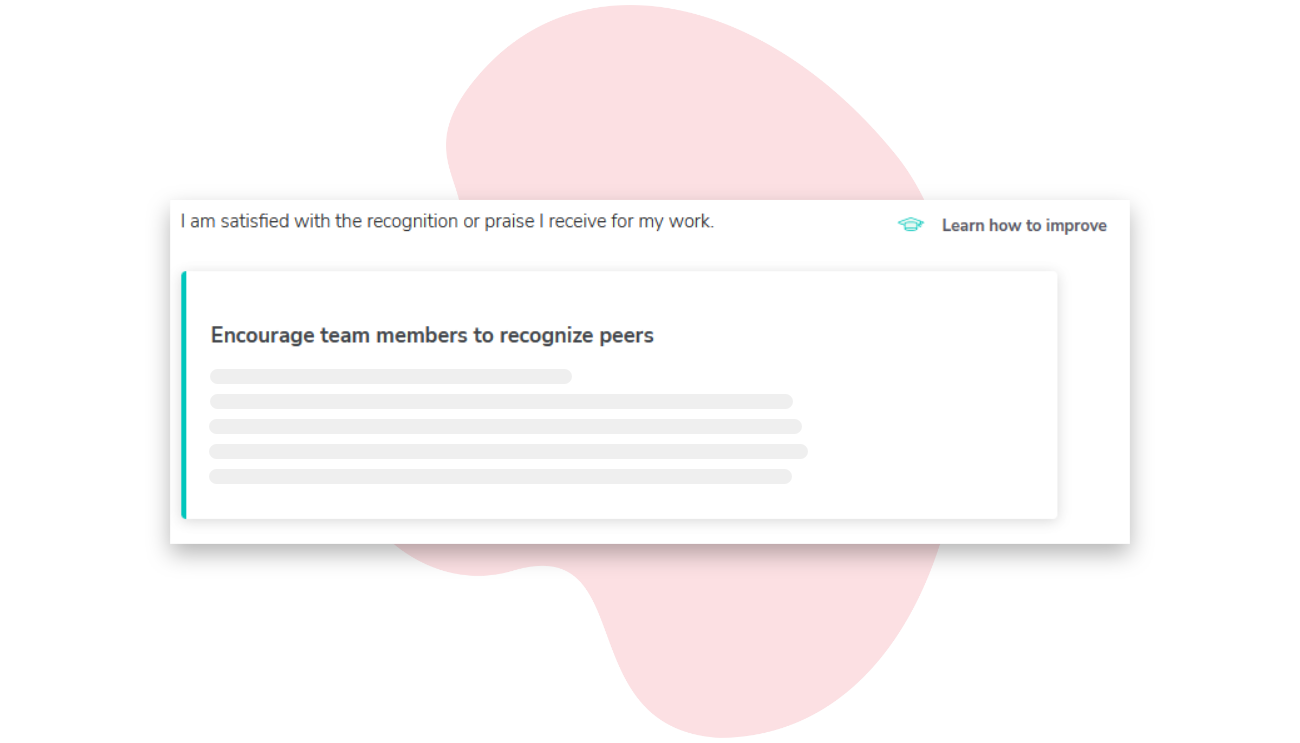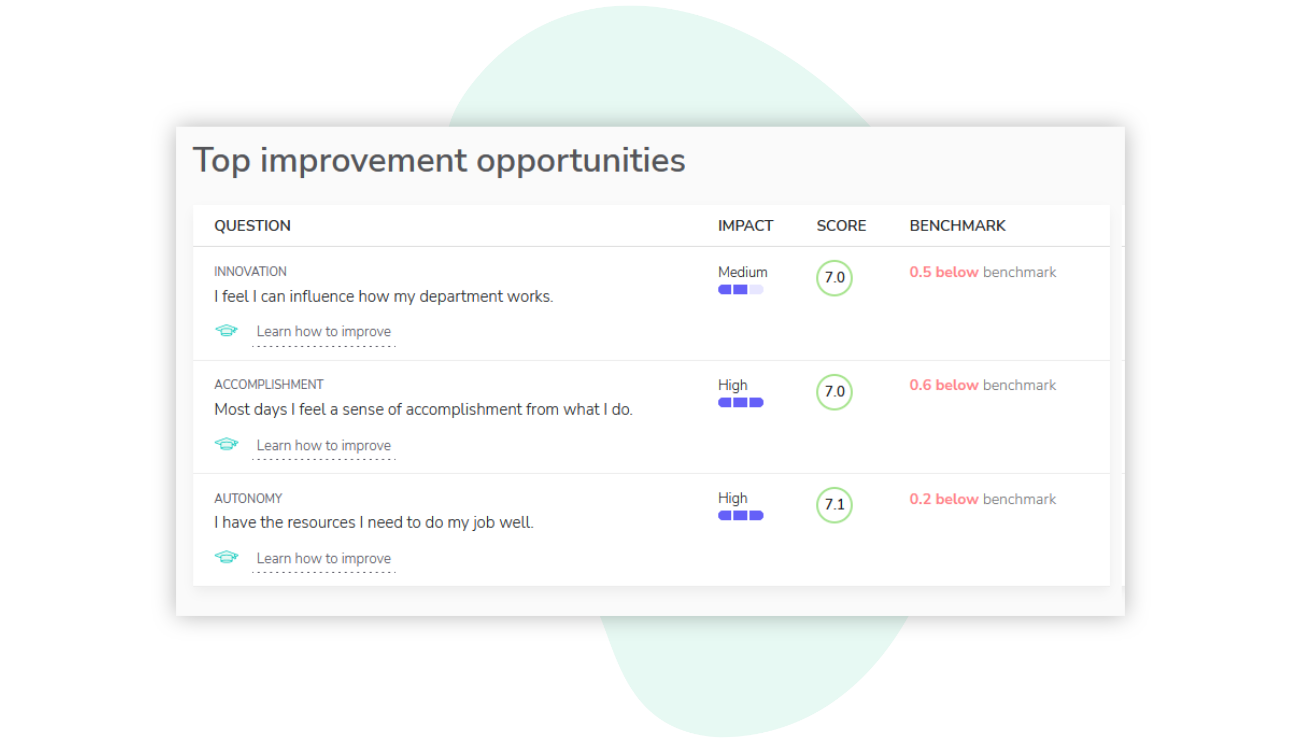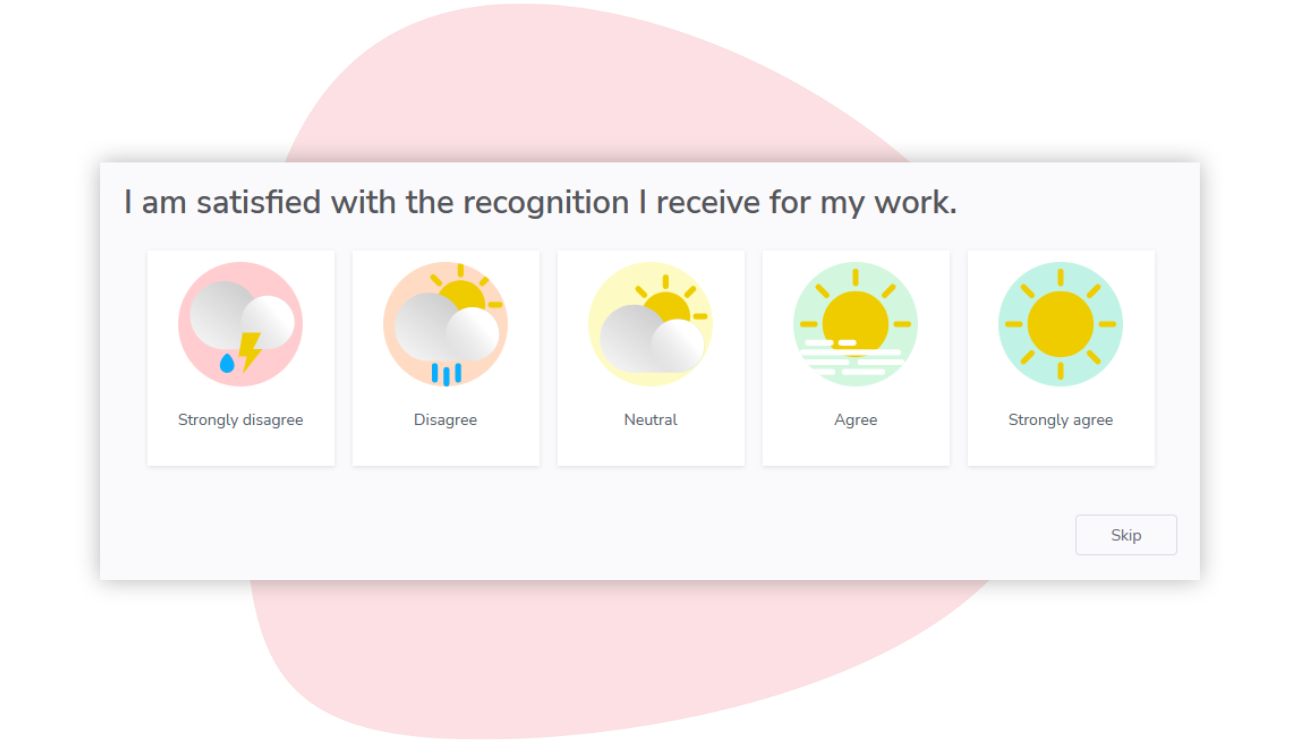You know what they say: the only permanent thing in life is change, and this is no less true for organizations.
Organizations must undergo change. It’s how they adapt to evolving market conditions, customer demands, and technological advancement.
At the same time, adapting to change can be a disruptive event. If change isn’t managed correctly, it can negatively impact an organization. It can impact how employees feel about their work environment causing them to limit their performance or leave altogether.
Change readiness surveys offer a way for companies to protect and evolve their culture while navigating change.
They can mitigate the risks associated with change and bring their people along with them on the journey, so they don’t feel alienated or disengaged.
A change readiness survey can help you evaluate how prepared your organization is to navigate change. It can also determine how well you’re managing change if it’s already in the works, so you can make adjustments as you go.
To get started, check out a few of these change readiness survey questions.
Top Change readiness survey questions:
- I believe a clear vision has been developed and communicated regarding this project.
- I understand the key objectives and desired outcome of this project.
- I understand the impact this project will have for you and your responsibilities within the organization.
- I understand why this project is taking place now.
- My direct manager shows a clear understanding of their role and responsibility to make this effort a success.
- My direct manager encourages me to get involved.
- I feel listened to with regards to my views on this project.
- I will actively support this project.
- My peers speak positively about this project.
- I am confident that this project will succeed.
I believe a clear vision has been developed and communicated regarding this project.
One of the principles of change management is understanding the change. This understanding must extend to your entire team. It’s useful if everyone in the organization understands:
- What exactly the change is
- Why the change is happening
- How it will be accomplished
It’s also important to communicate what this change will mean for people individually.
Without a clear understanding of the impact, employees will rely on their own assumptions or the rumor mill.
This is not an ideal situation, especially if you want to avoid losing people during this process.
If people think they'll be losing their job, they’re more likely to divert their attention from their day-to-day work towards interviewing for different roles.
So how do you set a clear vision for your organization’s change?
First, paint a picture of what the future will look like.
Why should your employees sacrifice their time and effort to work towards this change?
Will their jobs be easier?
Will they make more money?
Will the company’s position be solidified, thus securing their jobs as well?
These are all questions that your picture of the future should answer.
Second, find data to back up your picture of the future.
Why are you making this change?
Is the market trending in this direction?
Does your customer data suggest that your users are looking for a functionality your company doesn’t yet have?
Are you falling behind your competitors when it comes to innovation?
Once you’ve outlined your aspirations for the future, hold up that lofty vision with some proof points.
Third, keep it simple. Think of your employees as your “internal market.” You’re trying to sell this change to them, so they will remain loyal to your company and invest their time and effort.
It’s easier to implement change if naysayers are shut down by their colleagues rather than just their managers.
In other words, you want your employees to say, “This is kind of inconvenient, but it makes sense in the long term” rather than, “Management is all over the place. I don’t know how much longer I’m going to stay here.”
I understand the key objectives and desired outcome of this project
What are the key objectives of this project and what do you hope will happen? If these aren’t clear to your team, they can’t put the disruption they’re experiencing in context.
Your people will experience a departure from their usual way of working. Help them understand why – and what they’re working towards – by articulating your key objectives and desired outcome of the project.
If you’ve received a low score on this project, it’s a sign that you need to improve your internal communications strategy around this change.
Identify what kind of change management you’re executing. It could be a change that:
- Aligns your internal operations and company culture to meet market changes and customer expectations
- Creates a culture of innovation and experimentation within your organization
- Overhauls a critical, but outdated, IT system with a new, more flexible system
Once you’ve identified the category, specify what you’re trying to accomplish:
- Our main objective is to shift from a product-based company to a service-based company in order to prosper in the face of increasing commoditization in our market. Our desired outcomes are to 1) create a culture that focuses on customer success to increase long-term relationships with clients and consumption of our products, 2) develop a culture of innovation that can come up with service-based value-adds to our products that differentiate us from the competition, and 3) shift from a licensing-driven business model to a consumption-driven business model.
This clarity will help your team understand why you’re making changes, what success looks like, and for those who are driven, how they can develop their own skills to deliver the most value.
I understand the impact this project will have for you and your responsibilities within the organization.
“Should I start looking for another job?” This is the main question that will be going through your employees’ heads as they start to hear about a merger or a change to your company’s organizational structure.
Let’s assume that your organization’s goal is to switch from a product-focused business to a service-focused business.
For your sales team, this will mean a change to their compensation structure.
Instead of being compensated for how many seats or licenses they sell to an organization, they’ll be compensated for the amount of consumption that customer offers.
If this impact isn’t explained early and clearly, it could lead to frustration and turnover.
Consider which areas of your organization will be extremely impacted by this change (e.g., sales, finance, marketing) and find a way to communicate what the main changes will be. This accomplishes a few things:
- Creates transparency and builds trust: If your teams are given clear and reliable information from the beginning, they can trust future communications, especially when there are challenges.
- Socializes the change: Your team has time to get used to the idea of the change before it goes into effect. This also gives them the time to consider how they can be happy at the organization instead of reactively wanting to look for another role.
- Gives people time to prepare: Unless it’s a party or a present, people generally don’t like surprises. Telling people their jobs have dramatically changed with little notice or support can be frustrating. Give them time to understand what’s happening so they can prepare.
I understand why this project is taking place now
It’s not uncommon for people to do their jobs without paying much attention to the market they’re operating in.
Avoid assuming that everyone in your organization has the same understanding of the reason for this change that you do.
Make it clear not only what the change is and why it’s happening, but why it needs to happen now as well.
You can explain factors such as the need to:
- Keep up with the market: The people in your organization will at the very least know who your competition is. If the change is because your competitors are outpacing you in terms of product innovation and service delivery, provide this context, offer proof points, and show how this change can not only protect the company, but jobs as well.
- Streamline processes: Overhauling a central system that’s used by everyone is frustrating. But there are probably elements of the system that everyone finds frustrating. Focus on how your change will solve these problems and how it will give people more time to interact with customers or colleagues and less time troubleshooting situations or completing repetitive manual tasks. You can emphasize how the money saved by this investment can be re-invested into other areas of the company.
My direct manager shows a clear understanding of their role and responsibility to make this effort a success.
When big changes are happening, individual employees look to their manager for guidance – even if the manager doesn’t have all the answers.
In response, managers can do one of two things: avoid conversations about the change process or practice transparency with their team.
Avoiding conversations creates the impression that either the manager doesn’t know what they’re doing or that they’re hiding something.
Both of these impressions can have a negative impact on a team.
The other option is to be open and honest, even if that means admitting “I don’t know.”
This creates the kind of trust that’s necessary for teams to navigate change without falling apart.
Another important role direct managers have is to create a comfortable space for employees to express their anxieties.
Are they worried about losing their jobs?
Are they worried they’ll be assigned to another team?
Again, even if managers do not have all of the answers, they can provide the support employees need to take the change day by day until more information is available.
My direct manager encourages me to get involved.
Change management experts recommend including your team in the upcoming change. Your ability to do this depends on your own involvement.
If it’s coming from the top down, then you may be limited.
If you are playing a role in the change – or you’ve initiated the change yourself – you can find opportunities to fold your employees into the process.
A few ways you can involve your employees is by:
- identifying areas of change that affect them and asking for their thoughts so you can pass them on to the people in charge of the project
- asking your employees to share their feelings about the change and what they’re worried about
If this is a project that you’re leading yourself, you can take this a step further by:
- asking for your employees’ input during the planning stage
- sharing the “why” behind the project and asking your team to provide feedback or share their thoughts on the project’s vision
- scheduling regular checkpoints about the project’s progress, and do your best to avoid re-scheduling these checkpoints
- asking your team how they feel about the implementation of the project throughout the process
- showing appreciation and rewarding your team members for their contributions
I feel listened to with regards to my views on this project.
Great leaders practice active listening. They care what their employees think and they take the time to listen non-judgmentally.
This is even more important during a big change. With the regular rhythm of work disrupted and incomplete information, it’s easy for small inconveniences to get wrapped up in frustration and confusion and turn into big problems.
If your team gives low scores for this question, it’s a sign that there’s a communication problem that must be addressed before it impacts the morale of your team.
Be mindful that you’re doing the following:
- Making time: Do you have a regular project checkpoint in the calendar? This checkpoint should be unrelated to a specific task or deliverable. It should just be an opportunity for a team member to touch base, get your guidance or feedback, ask general questions, and express any concerns about the project’s progress.
- Actively listening: Are you listening to what your team members have to say or are you waiting to speak? Listen to understand, not to respond.
- Incorporating feedback: If you hear something important, act on it. Demonstrate that these check-ins are meaningful and not just a checkbox exercise.
- Provide anonymous ways to provide feedback: Some members of your team might not feel comfortable providing feedback. Provide methods where people can submit their comments anonymously, like through an anonymous survey.
I will actively support this project.
It’s natural for people to resist change, especially if they’ve become used to doing something a certain way for a long time.
If a large number of your team members say they will not actively support your project, here are a few things you can do to get them on board:
- Paint an inspiring picture: Capture the vision of this project in a key statement. Organize and release a campaign. Have a meeting where you go through a presentation of what this change will lead to. Whatever it is, just be sure to make it inspirational so you can get your entire team on board.
- Be calm: Don’t overreact when there are mistakes or missteps. Calmly coach and help employees to course correct.
- Share progress: Highlight when you’ve made progress as a team. When you’re in the thick of things, it can be hard to see just how far you’ve come or easy to wonder whether your manager is even noticing the effort.
- Tie change to professional growth: Find opportunities to tie your organization’s change to your team’s career opportunities and professional growth. This could be an opportunity for them to gain new skills and gain new experiences.
My peers speak positively about this project.
How does your team talk about this new project or change amongst themselves? Is the talk positive, or is there resentment and apprehension? How your team feels about a project will determine how much effort they put towards ensuring its success.
I am confident that this project will succeed.
If your employees don’t feel confident about the project’s success, this can hinder your ability to successfully complete it. There are a few possible causes for this lack of confidence:
- Uninspiring vision: Is there a larger story around this change, or has it just been dumped in your team’s lap? Pump up the energy by inspiring your team members.
- Unclear goals and objectives: What exactly are you trying to accomplish? Are your team members getting new tasks each and every day and told they’re all equally urgent? This can get demoralizing really quick. Instead, ensure there’s a clear end goal and objective, so they can work towards it and manage their work accordingly.
- Limited communication: Are there opportunities for your team members to ask questions? Receive guidance? Get feedback? If not, you’ll need to work this into your calendar.
The benefits of a robust employee survey platform
A robust employee survey platform such as Sparkbay can help leaders understand obstacles and opportunities and focus their efforts where it matters. It can also track engagement and satisfaction over time to identify which actions are working and which aren't.

Explore employee data any way you want
It is important to be able to segment data based on demographics such as tenure and role. Sparkbay allows leaders to interrogate their data in any way they want to uncover deeper insights about their people.

Empowers action
Surveying employees serves no purpose if leaders do not take advantage of the opportunities they discover. With Sparkbay's automated coaching, managers can act on easy-to-implement strategies. These tools drive action to ensure you meet your employee-centric objectives.

Provides robust benchmarks
Leaders need to compare their survey results with industry benchmarks to understand how they are doing. Using the right survey platform, you can compare your survey data with others in your industry, similar-sized companies, and top employers.

Equips managers with dashboards to visualize their results
Manager dashboards help managers visualize their survey results all in one place. With these dashboards, managers can easily track employee experience trends, and identify strengths and opportunities.

Provides a seamless user experience
You don't want your managers to waste valuable time on a clunky, hard-to-use platform. We designed Sparkbay with simplicity in mind. Your managers will master our intuitive dashboards in no time.

Gain access to real-time results
Taking action is the most significant part of your survey strategy. That’s why Sparkbay's real-time results let you expedite your process and propel insights into action.

Use an employee survey software to stay in the loop about how your employees feel
Sparkbay’s employee survey software makes it easy for employers to understand their employees readiness for change.
Our tool makes it easy for organizations to distribute surveys and track data while keeping all employees’ responses anonymous.
If you're interested in learning how Sparkbay can help you understand their employees readiness for change, you can click here for a demo.

